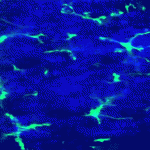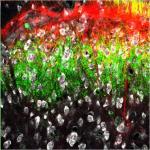Publication Type:
Journal ArticleSource:
J Physiol, Volume 463, p.391-407 (1993)Keywords:
Algorithms, Animals, Electrophysiology, GABA-B Receptor Antagonists, gamma-Aminobutyric Acid, Hippocampus, In Vitro Techniques, Kinetics, Male, Membrane Potentials, Organophosphorus Compounds, Rats, Rats, Wistar, Receptors, GABA-B, SynapsesAbstract:
<p>1. Tight-seal, whole-cell voltage clamp recording techniques were used to characterize monosynaptically evoked GABAB currents in adult rat brain slices maintained at 34-35 degrees C. Responses were recorded from granule cells of the dentate gyrus following the blockade of 6-cyano-7-nitroquinoxaline-2,3-dione (CNQX)-, D-2-amino-5-phosphonovaleric acid (D-AP5)- and picrotoxin-sensitive fast synaptic transmission, so that the remaining synaptic currents could be studied in isolation. 2. Under these conditions, stimulation in the molecular layer elicited a slow outward current which was blocked by the selective GABAB antagonist CGP 35348 in a concentration-dependent manner (200-800 microM). This current was absent in recordings made with pipettes containing 10-15 mM of the lidocaine derivative QX-314 or when caesium was substituted for K+. 3. Increasing the [K+]o e-fold (from 2.5 to 6.8 mM) shifted the reversal potential of the GABAB current from -97.9 to -73.2 mV, as predicted by the Nernst equation. Peak conductance was constant, but in 6.8 mM [K+]o at voltages hyperpolarized to EK (equilibrium potential for potassium), a small outward rectification was evident. 4. The time course of the current could be described by fourth-power exponential activation kinetics with double exponential inactivation. At 34-35 degrees C, the average activation time constant (tau m) was 45.2 ms, while the two inactivation time constants (tau h1 and tau h2) were 110.2 and 516.2 ms, with corresponding weighting factors (wh1 and wh2) of 0.84 and 0.16, respectively. The Q10 (temperature coefficient) values for these time constants were between 1.82 and 2.31. Neither tau m, nor tau h1 and tau h2 were voltage dependent in the range from -45 to -95 mV. 5. Paired-pulse depression of the GABAB current was studied by giving identical conditioning and test stimuli over a wide range (50-5000 ms) of interstimulus intervals (ISIs). The maximal depression (48%) occurred at 200 ms ISI, and the depression lasted for over 5 s. The magnitude of paired-pulse depression was not dependent on the postsynaptic membrane potential. 6. Application of the competitive antagonist CGP 35348 such that the peak current was diminished by approximately 50% had no effect on the activation or inactivation kinetics of the current. Similarly, during paired-pulse depression the kinetics of test currents were identical to those of conditioning currents. These findings support the hypothesis that the mechanism responsible for paired-pulse depression involves a reduction in neurotransmitter release without postsynaptic alterations in K+ channel activation/inactivation kinetics.(ABSTRACT TRUNCATED AT 400 WORDS)</p>



